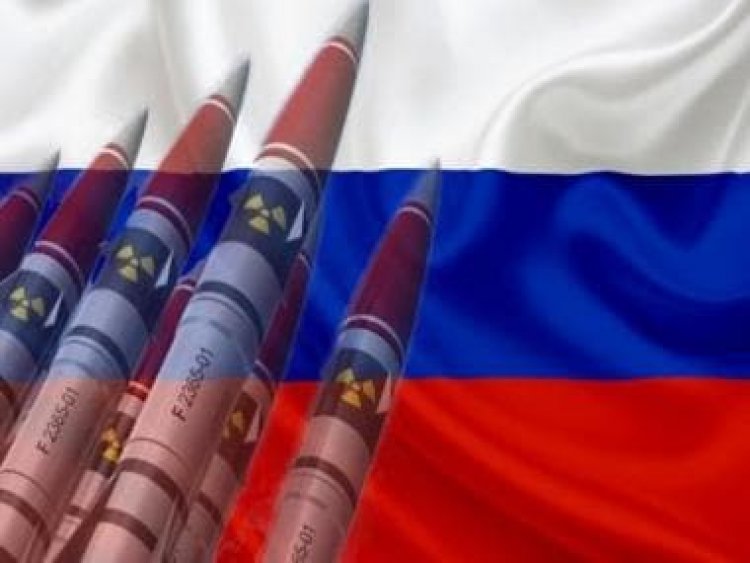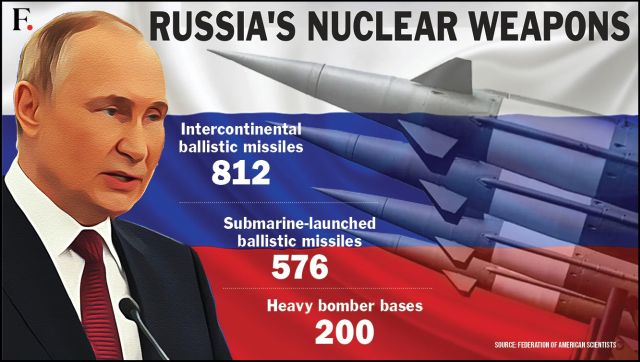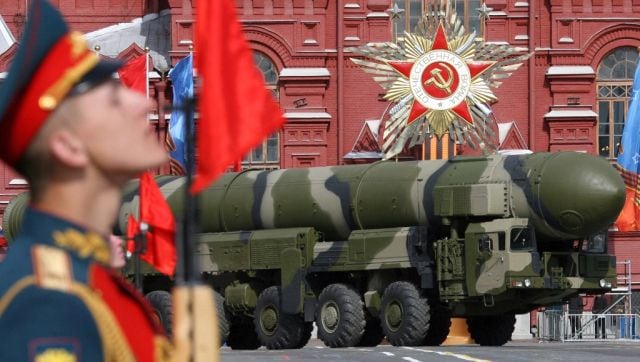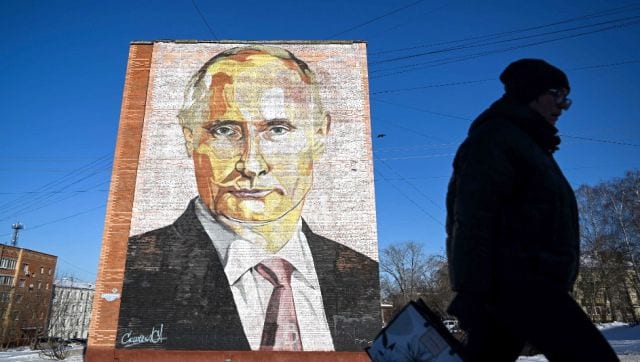As Vladimir Putin raises nuclear threat one year into the war, a look at Russia’s nuclear arsenal
As Vladimir Putin raises nuclear threat one year into the war, a look at Russia’s nuclear arsenal

On 24 February 2022, Russian president Vladimir Putin announced the special military operation into Ukraine to de-Nazify the country. A year on, the Russia-Ukraine war wages on with little hope of it ending any time soon.
Neither side has released any official figures lately, but analysts estimate that about 200,000 Russian troops have been killed or wounded in the war so far. Ukraine has seen 100,000 killed or wounded in action. And that’s only the military losses. The war by some estimates have cost both countries over $100 billion and counting.
Despite the heavy losses — economically and physically — both sides refuse to relent. Neither Russian leader Vladimir Putin nor Ukrainian president Volodymyr Zelenskyy shows any signs of backing down and abandoning one of the largest military conflicts since the end of World War II. For the civilians caught in the crossfire, that means the bloodshed and suffering brought on by the war has no discernible end.
And now one year on, there’s a more palpable fear that this war could go nuclear. Three days ago, Vladimir Putin in his state-of-the-nation address announced Russia’s suspension of the New START treaty, the last remaining nuclear arms control treaty with the United States.
When asked to react to Putin’s announcement, US president Joe Biden said: “Big mistake.” His Secretary of State Antony Blinken added that it was “deeply unfortunate and irresponsible.”
On Wednesday, Putin once again reiterated that Russia was ready to “use all the instruments at its disposal to counter a threat against its territorial integrity”, raising the spectre of waging a nuclear war.
The terrifying but true reality is that we cannot know for certain if Putin will use nuclear weapons at this point of time, but it still begs the question — how many nuclear weapons is in Russia’s arsenal?
Counting Russia’s nukes
Russia, which inherited the Soviet Union’s nuclear weapons, has the world’s biggest store of nuclear warheads.
According to the Federation of American Scientists, Russia has 5,977 nuclear warheads as of 2022. Of this, around 1,500 warheads are retired, 2,889 are in reserve and around 1588 are deployed strategic warheads.
The Federation of American Scientists add that about 812 of Russia’s nuclear warheads are deployed on land-based ballistic missiles, about 576 on submarine-launched ballistic missiles, and around 200 at heavy bomber bases.

Also read: One year of Russia-Ukraine war: What has happened thus far
Compare this to the world: The United States has 5,428 weapons of a nuclear nature, while China has a growing arsenal of 350 warheads. France has 290 warheads, followed by UK’s 225 warheads. Pakistan and India have 165 and 160 warheads respectively followed by Israel having 90 warheads. North Korea with 20 warheads is currently increasing its stockpile.

This means that Russia and US have 90 per cent of the world’s nuclear weapons.
There’s also talks that Russia in view of the war is expanding and modernising their nuclear forces, causing more concerns among the West and Ukraine’s allies.
Who controls Russia’s nuclear weapons?
Owning a significant number of nuclear weapons is no doubt a big responsibility and in Russia, this responsibility lies on the shoulders of the president — currently, Vladimir Putin. The nuclear codes of the country are held in the nuclear briefcase called the Cheget and is in the president’s possession at all times.
News agency Reuters reports that Russia’s defence minister Sergei Shoigu and the chief of the general staff, currently Valery Gerasimov, are also thought to have such briefcases.
The briefcase is a communication tool which links the president to his military top brass and hence, to rocket forces. Footage shown by Russia’s Zvezda television channel in 2019 showed what it said was one of the briefcases with an array of buttons.
If Russia thought it faced a strategic nuclear attack, the president, via the briefcases, would send a direct launch order to general staff command and reserve command units which hold nuclear codes. Such orders cascade swiftly down different communications systems to strategic rocket force units which then fire at the United States and Europe.
How destructive are Putin’s nuclear weapons?
The short answer to this is: Catastrophic.
Understand this: The atomic bomb that was dropped in Hiroshima during World War II was 15 kilotons. This attack killed up to 146,000 people, maimed hundreds of thousands of people, and their effects are still being felt today.
Today’s nuclear warheads can be more than 1,000 kilotonnes — that’s more than six times more potent than the Hiroshima bomb.

Russia’s intercontinental ballistic missiles, which have the capability of carrying nuclear warheads, can reach and destroy major global cities such as London or Washington. A SkyNews report stated that ICBMs can reach a top speed around 10 minutes after launch which could see one fired from Russia reach the UK in just 20 minutes.
On the eve of the Russia-Ukraine first year anniversary, Putin also announced that the delayed Sarmat intercontinental ballistic missile would be deployed this year. Dubbed Satan 2 by Western analysts, it can be deployed with 10 or more warheads on each missile and can hit any target on Earth. According to experts, this missile has a range of 18,000 km, but some estimate this to be higher. Incidentally, the distance between Moscow and Washington is around 9,000 km, meaning the Sarmat could reach US twice over — if that’s even possible.
Explaining just how powerful is Putin’s nuclear weapons, defence expert General Sir Richard Barrons told SkyNews, “An intercontinental ballistic missile can reach from Russia to the US and obviously into Europe. The warhead at the front of it has a yield of between 300 and 800 kilotonnes (of TNT equivalent). Three hundred kilotonnes is enough to destroy Washington or London or Paris.”
Besides the ICBMs, Russia has smaller weapons that would still bring devastation. For instance, the 2S7 gun – 203mm calibre – has a range of about 37 km and can fire a nuclear shell with a yield of about one kilotonne.
The Russian strongman can also turn to Iskander missile that has a range of 500 km and can be used to fire a nuclear weapon with a yield of between five and 50 kilotonnes.

Will Putin use nuclear weapons in 2023?
While no one knows what Putin is thinking and which direction will he choose in the Russia-Ukraine war, the shadow of nuclear weapons is hanging even more prominently now. His suspension of the New START treaty is just an indication of that.
The Nobel Peace Prize-winning International Campaign to Abolish Nuclear Weapons (ICAN) has said that as the war prolongs, the more likely nuclear weapons will become a greater part of this conflict.
Also read: Will the Russia-Ukraine conflict end in 2023?
“The world faces a grave risk of nuclear weapons being used for the first time since 1945. “The longer Russia decides to continue its invasion, and military operations, the more likely nuclear weapons will become a greater part of this conflict. It;s something the world should be taking very seriously,” said Daniel Hogsta, the interim executive director of ICAN.
However, some experts believe that all of Putin’s mentions and warnings of nuclear weapons is just sabre-rattling. Serhii Plokhy, a Harvard University professor of Ukrainian history, told NPR that he doesn’t think Putin would ever follow through with his nuclear threats, given the likelihood of a full military response from the West.
“Putin is not suicidal. The war is there to preserve his position in power,” he said.
Justin Bronk, a senior research fellow at RUSI in London, echoes similar views. “Actually using them (nuclear weapons) generates almost no practical benefits at all and certainly nothing to compensate for all of the costs, both in terms of immediate escalation risk — irradiating things they want to hold on to and be part of — and also pushing away the rest of the world,” he said to ABCNews.
Gordon Corera, a security correspondent for BBC, said that Putin’s nuclear warnings is his effort to remind world powers of the weapons and intimidate and deter his opponents and force them to rethink how far they are willing to push.
Corera added that Putin’s nuclear mentions is also a way of him reassuring his people that despite the war continuing for so long, the country remains strong and capable of defending itself.
With inputs from agencies
Read all the Latest News, Trending News, Cricket News, Bollywood News,
India News and Entertainment News here. Follow us on Facebook, Twitter and Instagram.
What's Your Reaction?



























































